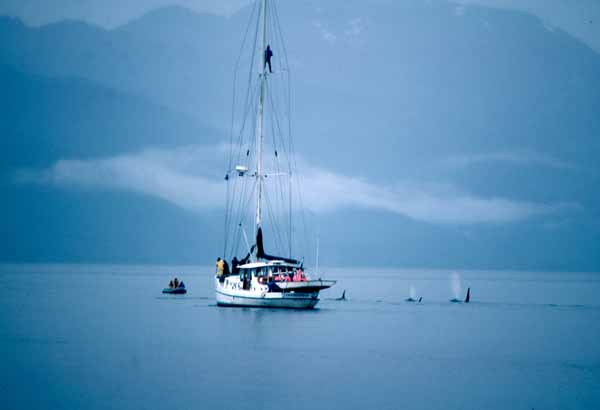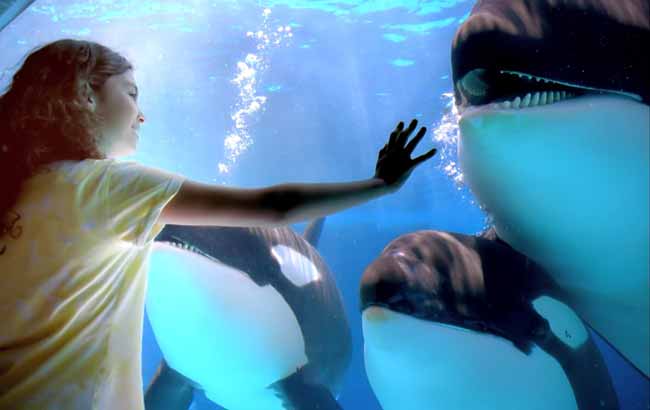IUCN / The World Conservation Union
IUCN/The World Conservation Union is a worldwide conservation organization. It links together government agencies, non-government agencies, and independent states to encourage a worldwide approach to conservation.
The IUCN's Red List is a system for assessing an animal's relative risk of extinction. Its goal is to categorize and raise global awareness of species that face a high risk of extinction. The killer whale is categorized as "data deficient." There is inadequate information to make a direct, or indirect, assessment of the species risk of extinction based on its distribution and/or population status.

Marine Mammal Protection Act (MMPA)
The U.S. Marine Mammal Protection Act (MMPA) of 1972 made it illegal to hunt or harass marine mammals in the U.S.
- The primary objective of the MMPA is to maintain the health and stability of the marine ecosystem and to obtain and maintain an optimum sustainable population of marine mammals.
- According to the MMPA, all whales in U.S. waters (baleen and toothed) are under the jurisdiction of the National Oceanic and Atmospheric Administration (NOAA).
- The MMPA does allow for certain exceptions: native subsistence hunting; taking marine mammals for research, education, and public display; and taking restricted numbers of marine mammals incidentally in the course of fishing operations.

Endangered Species Act (ESA)
The Endangered Species Act of 1973 (ESA) conserves endangered species and their ecosystems. A species is considered endangered if it is in danger of extinction.
- As defined in the ESA, a protected "species" may be a species, a subspecies, or a distinct population segment (DPS).
- In 2005, the Southern Resident killer whales of the eastern Pacific Ocean were listed as an endangered DPS under the ESA. The population was estimated at 200 whales in the late 1800s and currently stands at about 85 whales. This DPS faces risks including vessel traffic, toxic chemicals and competition for food, especially salmon. The small DPS is also susceptible to potential catastrophic risks, such as disease or oil spills.
- NOAA Fisheries and the U.S. Fish and Wildlife Service (USFWS) share responsibility for implementing the ESA.

The Convention in International Trade of Endangered Species (CITES)
The Convention in International Trade of Endangered Species (CITES) is an international treaty developed in 1973 to regulate trade in certain wildlife species. Killer whales are listed under CITES Appendix II: species that are not necessarily now threatened with extinction, but that may become so unless trade is closely controlled.
Species at Risk Act (SARA)
In Canada, the Species at Risk Act (SARA) became law in 2003. A main purpose of SARA is "to proved for the recovery of wildlife species that are extirpated, endangered or threatened as a result of human activity".
- Under SARA, the "West Coast transient" population of killer whales was listed as "Threatened" and issued a recovery strategy to deal with dangers that includes bioaccumulation of toxins in prey items and physical and acoustic disturbances.
Research
Scientists all over the world continue to study the abundance, biology, reproduction, migration and behavior of killer whales.
The study of captive cetacean populations in controlled research settings has provided fundamental information on many species-specific aspects of their biology. Observing cetaceans in marine life parks allow for long-term, fine-scale studies that would be difficult to achieve in the ocean and such studies add to our overall knowledge of cetaceans and supplement fragmented information from observations in the wild.

A contribution to our understanding of the basic physiological processes in killer whales has been derived from captive populations including adaptations to diving, auditory detection, echolocation and learning, reproductive physiology, growth and development, metabolic and energy requirements, health status, immune system function, and genetics.
The utility of these captive studies for health assessment and conservation strategies for free-ranging cetacean populations requires that captive populations are healthy and thriving. In the killer whale and other delphinids, commonly used population health indicators are reproductive success and age-specific survivorship patterns. Recent analysis of captive bottlenose dolphin (Tursiops truncatus) populations, a species closely related to killer whales, demonstrated that reproductive success and survivorship patterns are comparable to or exceed those experienced by their wild counterparts. As such, these captive populations can provide models for understanding geriatric changes and impacts of unique age or event-specific physiologic stressors to wild populations.

The non-profit SeaWorld & Busch Gardens Conservation Fund works on behalf of wildlife and habitats worldwide. The goal of the Fund is to encourage sustainable solutions by supporting critical conservation initiatives worldwide.
- The SeaWorld & Busch Gardens Conservation Fund supported a study on killer whale energetics to help determine how whales have solved the complex bioenergetic relationships of energy intake and expenditure and what impact they are eventually having on their system. The study measured the metabolic rates of killer whales at SeaWorld. This data was then used to estimate energy needs of the whales in the wild.
- By assessing the metabolic rate of captive killer whales and relating it to heart rate, the study can be used to evaluate metabolic expenditures of free-ranging whales and ultimately apply this information to the conservation and protection of wild whales, such as the endangered population of Southern Resident killer whales.
- With support from the SeaWorld & Busch Gardens Conservation Fund and aerial data collected from SeaWorld’s killer whales, the Vancouver Aquarium and the National Oceanic Atmospheric Administration (NOAA) are working together on a first-ever project that uses unmanned aerial systems (UAS) to study killer whales in their natural habitat. The UAS’s allow scientists to gather information and monitor the changing dynamics of protected Pacific Northwest killer whale populations.
- Killer whales at SeaWorld San Diego participated in overhead photo sessions which documented shape relative to weight and changes in size during pregnancy for comparison with wild whales. The data collected at SeaWorld will help researchers determine if food availability, calf mortality or other factors play a role in population dynamics for the Southern and Northern resident populations in the wild.
- There are key advantages to aerial observation of aquatic mammals. Scientists can determine much more about a whale’s health and condition from above than from surface level, including the ability to monitor nutritional status through body shape. Importantly, the small UAS’s can go undetected by the whales, which gives researchers a less invasive and more accurate window into the whales’ habits and lives.
Whale watching
Whale watching expeditions bring people close to wild whales and help people learn about them. In British Columbia and the state of Washington, killer whales are the most popular cetacean of commercial whale watching companies.
The steady growth of recreational whale watching has raised some concerns with killer whale researchers. Higher concentrations and closer proximity of boats can force whales away from their traditional habitats.
The National Oceanic and Atmospheric Administration (NOAA) Fisheries has developed “Marine wildlife viewing guidelines” to protect marine animals. Among other recommendations, the guidelines instruct whale watchers to keep their distance. Impeding the whales’ right of way is not allowed. Chasing, harassing, touching and feeding animals also are prohibited.

Marine Zoological Parks
SeaWorld trainers and veterinarians perform regular health exams on the killer whales to monitor and maintain their health.
In the protected environment of a marine zoological park, scientists can examine aspects of killer whale biology that are different or impossible to study in the wild.
The unique opportunity to observe and learn directly from live animals increases the body of scientific knowledge and enhances public awareness and appreciation for wildlife.
- Up until the 1970s, killer whales were mainly regarded as a nuisance animal. Attitudes began to change dramatically, mainly due to displays at marine life parks that allowed people to learn about and appreciate killer whales like never before. Killer whales provide the opportunity for zoological parks and aquariums to play a unique and unrivaled role in marine mammal education and conservation. Educational shows and programs at marine life parks can make a difference. Independent studies have concluded that guests viewing dolphin shows demonstrated an increase in conservation-related knowledge, attitudes, and behavioral intentions immediately following their experience.
- Sweeney’s 2009 study aimed to better understand learning in zoological settings, particularly learning about marine mammals through interaction programs.
- Her research concluded that all participants gained new knowledge within three broad categories:
- dolphin physiology and natural history
- care and training of dolphins and
- conservation
- All participants in the study constructed personal meanings by connecting the activity to experiences, beliefs, and practices outside the interaction context. Almost all participants made associations with conservation.
- Most participants shifted their attitudes and gained a sense of personal agency about beginning or increasing stewardship actions.
- Visitors learned interspecies etiquette skills and trainers learned skills in dolphin training and management, people management and teaching.
- Visitors maintained long-lasting memories of the experience that occurred eight months to 18 years in the past.
- Her research concluded that all participants gained new knowledge within three broad categories:
- Studies like these confirm the results of a Harris Interactive® poll the Alliance commissioned in 2005.
- The Harris poll found that the public is nearly unanimous (95%) in its acclaim for the educational impact of marine life parks, zoos, and aquariums. In addition, 96% of respondents agree that these facilities provide people with valuable information about the importance of our oceans and the animals that live there.
- In April 2010, the journal Nature published an article citing evidence that most of what the general public knows about science is learned outside of a school classroom through visits to places like zoos and museums, websites, and magazine articles.




